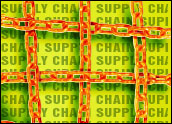
The supply chain management applications market grew by 3 percent to US$5.6 billion in 2005, according to a new report by AMR Research. It was the second year of growth for the sector, and it exceeded the firm’s expectations of a 1 percent increase. 2006 promises to be even stronger, with AMR calling for a 7 percent increase as more and more companies refocus on SCM initiatives.
At the same time, certain subsectors with the SC software category surged by double digits last year. These include inventory configuration, which posted a license growth rate of 35 percent, and supply chain network design license growth, which grew by 21 percent.
The Software as a Service delivery model is the fastest-growing deployment method, AMR found, having increased at a rate of 16 percent.
Growth Factors
A number of factors account for these pockets of growth, explained report author and senior research analyst Mark Hillman.
“Spending is tempered by the fact that corporate supply chain organizational maturity is still relatively low, limiting adoption,” he said. “In addition, consolidation will continue to play a significant role in 2006.”
At the same, he continued, “new business focuses and pressures are driving pockets of vendor innovation and renewed corporate spending in supply chain initiatives.” These include globalization, leaner supply networks, increased customer expectations, more mass customization and increased demand variability.
Demand for Composite Applications
Other categories examined, which clocked in at growth rates between 4 percent and 35 percent, include order management, order promising, transportation management, international trade logistics, warehouse management, supply chain event management and visibility, manufacturing and distribution planning, production scheduling, demand planning and forecasting, collaborative forecasting, sales and operations planning, service parts management and replenishment, vendor-managed inventory, and supply chain performance.
While there is demand for applications within these subcategories, more companies are gravitating to service-oriented architecture (SOA) composite applications that are based on many different areas of functionality, i2 Technologies Chief Marketing Officer John Cummings told CRM Buyer. Delivering master workflows that knit together many different applications has been an area of i2’s focus over the last several years, he added.
“Firms want to get to the point where they can achieve continuous process improvement,” Cummings said. “We are seeing a lot of innovation in the collaborative space, for example, in order to get as close as possible to the demand signal.”
SAP is the top SCM vendor in terms of revenue, according to the report, having outpaced the market with growth of 6 percent. Oracle, i2,Manhattan Associates and Infor round out the top five vendors in revenue in the space.





















































